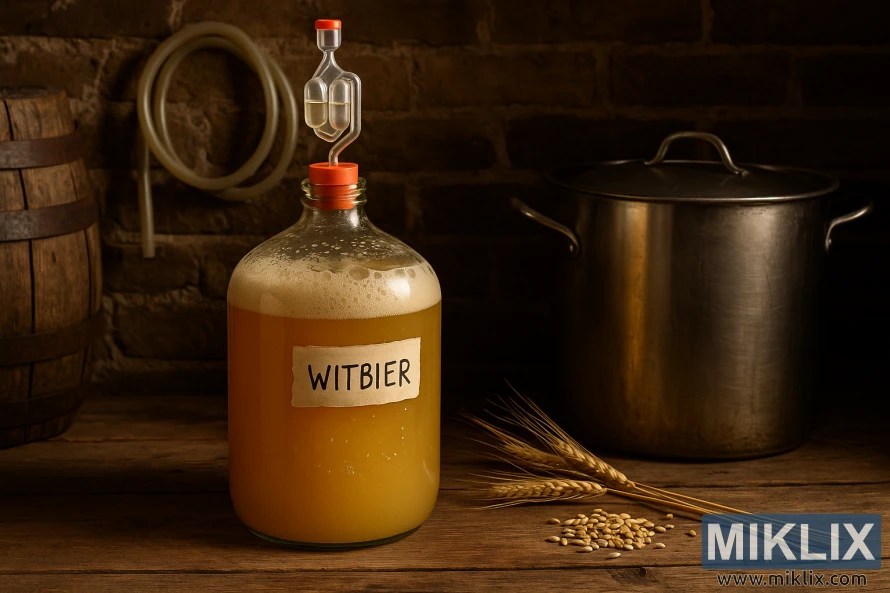Image: Rustic Witbier Fermentation Setup
Published: September 24, 2025 at 9:35:16 PM UTC
A rustic homebrewing scene shows a carboy of fermenting witbier with foam, airlock, and warm lighting on a wooden table.
The photograph captures a rustic homebrewing setup in a warmly lit environment, dominated by the central focus of a glass carboy filled with fermenting witbier. The carboy sits on a rough wooden surface that shows the marks of age and use, its planks bearing scratches, cracks, and uneven textures that speak to years of brewing activity. The fermenter itself is large and round with gently sloping shoulders that taper to a narrow neck, which is sealed with a bright orange rubber bung. Emerging from the bung is a classic plastic airlock partially filled with liquid, a detail that highlights the active fermentation process taking place inside.
The contents of the carboy are a cloudy golden-yellow liquid, typical of Belgian-style witbier, with a dense layer of foam clinging to the surface. This krausen, produced by the yeast during fermentation, suggests that the beer is in the early to active stage of fermentation. Bubbles cling to the glass, rising slowly toward the frothy top, adding to the sense of a living process in motion. A simple, handwritten label affixed to the carboy reads “WITBIER” in bold black letters, giving a personal and handcrafted feel to the scene. The paper label itself is slightly uneven and imperfect, reinforcing the rustic, homemade quality of the brewing project.
To the left of the fermenter, a loop of brewing hose hangs against the rough, dark brick wall, suggesting its use during the wort transfer or siphoning stages. The wall itself, built of irregularly textured bricks with worn mortar lines, contributes a sense of cellar-like coziness and an earthy atmosphere. Just below the hose sits part of a wooden barrel with steel hoops, a nod to traditional brewing and aging methods, though here it serves more as a decorative reminder of heritage than as a working vessel.
On the opposite side of the carboy, slightly behind it, a large stainless steel stockpot rests on the wooden surface. Its brushed metal sides are dulled and lightly marked with scratches, the kind of wear that comes only from long, practical use. This pot would have been essential in the brewing process, likely serving as the vessel for heating water, boiling wort, and steeping grains or spices. Its lid is closed, catching a subtle glint of the warm ambient light that permeates the room.
In front of the pot and leaning casually on the table are a few stalks of golden wheat, their long awns catching the light and emphasizing their texture. They are carefully placed alongside a small scattering of pale barley or wheat kernels, creating a subtle but evocative still-life arrangement that connects the raw ingredients to the final product fermenting in the carboy. These visual cues underscore the agricultural origins of brewing, linking the finished beer back to the fields where it began.
The overall lighting of the photograph is warm, low, and directional, reminiscent of the glow of late afternoon sunlight or perhaps the amber hue of an oil lamp in a rustic cellar. Shadows are soft but pronounced enough to give depth and dimension to every surface—the gleam of the stainless pot, the matte finish of the wood, the translucence of the bubbling witbier. This lighting enhances the sense of craft and tradition, evoking an atmosphere both intimate and timeless.
Altogether, the scene is a quiet celebration of the art of homebrewing. It balances the technical aspects of fermentation—the airlock, the foam, the equipment—with the rustic charm of its setting. The textures of wood, brick, metal, and glass come together to form a composition that is both functional and aesthetic, reminding the viewer that brewing is as much about patience, care, and tradition as it is about the science of yeast and fermentation. It captures a moment of transformation, where humble grains and water are becoming something greater: a glass of witbier full of flavor, history, and craft.
The image is related to: Fermenting Beer with Mangrove Jack's M21 Belgian Wit Yeast

